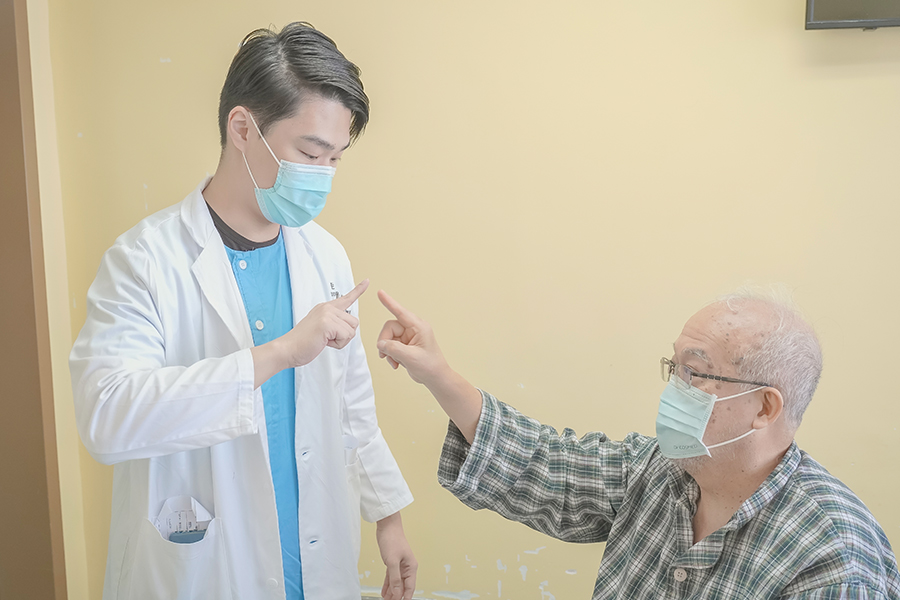Low-field MRI aids in treating acute stroke
 Time is brain. Without immediate intervention, acute stroke potentially results in hemiplegia, permanent disability, and even fatality. Last year, Prince of Wales Hospital (PWH) introduced a low-field magnetic resonance imaging (MRI) scanner to expedite the diagnosis of acute stroke, ensuring patients are spared from a lifetime of paralysis. “From seeing the doctor, undergoing initial assessments, imaging scans to treatment, all are done on the same bed and in the same room, reducing unnecessary patient transfers. The entire process is expected to be shortened and completed within 20 minutes,” states PWH Department of Medicine and Therapeutics Associate Consultant Dr Ma Sze-ho.
Time is brain. Without immediate intervention, acute stroke potentially results in hemiplegia, permanent disability, and even fatality. Last year, Prince of Wales Hospital (PWH) introduced a low-field magnetic resonance imaging (MRI) scanner to expedite the diagnosis of acute stroke, ensuring patients are spared from a lifetime of paralysis. “From seeing the doctor, undergoing initial assessments, imaging scans to treatment, all are done on the same bed and in the same room, reducing unnecessary patient transfers. The entire process is expected to be shortened and completed within 20 minutes,” states PWH Department of Medicine and Therapeutics Associate Consultant Dr Ma Sze-ho.
Acute stroke can be categorised into ischemic and hemorrhagic strokes. Both of which will deprive brain tissues of adequate nutrients and oxygen, leading to the necrosis of two million brain cells every minute, which in turn will affect the patient’s future mobility and ability to comnunicate. With over 10,000 acute stroke admissions annually in Hong Kong, 80% of which are ischemic strokes. If such patients can seize the golden opportunity to receive thrombolytic therapy within four hours of the onset, “every minute earlier to unclog and restore the blood flow of brain, slowing down the brain’s death process, the easier the path of recovery for the patient,” Dr Ma says.
Currently, suspected acute stroke patients arriving at the accident & emergency (A&E) department undergo a series of clinical assessments and tests at various locations within the hospital, including computed tomography (CT) scans. The entire process from admission to confirmed diagnosis of acute stroke and commencement of treatment takes an average of 66 minutes.
Transforming the diagnosis and treatment for wake-up stroke patients
The introduction of new low-field MRI scanner has accelerated the diagnostic and treatment process of acute stroke at PWH. Dr Ma explains that MRI scans provide clear brain images and enhance diagnostic accuracy. Low-field MRI offers several advantages over traditional MRI, requiring less space, eliminating the need for installation in specially shielded rooms, and allowing for flexible placement. Additionally, its low magnetic field characteristic reduces the time required for brain scans from approximately 30 to 40 minutes to just three to five minutes. The low-field MRI scanner is now placed in the Emergency Stroke Unit at PWH’s A&E, where suspected acute stroke patients are promptly directed to the room upon arrival. PWH has successfully handled 45 cases as of mid-December, with a 100% success rate in diagnosis.In early December last year, Mr Kwong, aged 71, woke up with weakness on his right side and difficulty walking. His family called an ambulance, rushing him to PWH, where a low-field MRI brain scan revealed an ischemic stroke. Still within the golden treatment window, he was immediately given a thrombolytic injection. “The entire treatment process went smoothly, and I never expected it to be completed so quickly. I am grateful to all the healthcare professionals for their diligent efforts in treating me,” Mr Kwong recalls.
 Dr Ma takes Mr Kwong as an example, he displayed no unusual symptoms before going to bed at midnight but woke up at 7am with stroke symptoms, which is a typical case of wake-up stroke. According to the usual practice, it would have been assumed that he had already missed the golden four-hour window for thrombolytic therapy. Low-field MRI enables doctors to pinpoint the actual onset time of the stroke, administer timely medication, thereby facilitating better recovery outcomes for patients. It has transformed the diagnosis and treatment for wake-up stroke patients. Diagnosed with a brain stem stroke, Mr Kwong was at high risk of hemiplegia. Fortunately, he received timely treatment. After around a week of prognosis, his mobility had significantly improved.
Dr Ma takes Mr Kwong as an example, he displayed no unusual symptoms before going to bed at midnight but woke up at 7am with stroke symptoms, which is a typical case of wake-up stroke. According to the usual practice, it would have been assumed that he had already missed the golden four-hour window for thrombolytic therapy. Low-field MRI enables doctors to pinpoint the actual onset time of the stroke, administer timely medication, thereby facilitating better recovery outcomes for patients. It has transformed the diagnosis and treatment for wake-up stroke patients. Diagnosed with a brain stem stroke, Mr Kwong was at high risk of hemiplegia. Fortunately, he received timely treatment. After around a week of prognosis, his mobility had significantly improved.